Shirley Moore, Chairperson for the Edwinstowe Historical Society, apologised for the fact that John Baird was unable to present his talk “Follow the Moon and Stars”. However, committee members were able to provide two illustrated talks, the first about Worksop Manor House, and the second about Edwinstowe Hall. Members were also able to view a display indicating Edwinstowe’s literary heritage.
The Historical Society had provided information to enable the local school children to join in the commemoration of the 80th anniversary of the D-Day landings, which was the largest seaborne invasion in history. Memories were also evoked of the time when Field Marshall Lord Montgomery paid an underground visit to Thoresby Colliery in 1947, later speaking to the miners and their wives in the Thoresby Colliery Institute. Afterwards, he met and spoke to village school children.

Monty’s visit to Fourth Avenue, Edwinstowe in October, 1947
Shirley referred to the list of vicars compiled by the Society and placed in St Mary’s church to assist visitors. Also provided for the church stewards was information relating to the church and churchyard.
At the Annual General Meeting held in May, Shirley Moore, Chairperson for the Edwinstowe Historical Society was pleased to report that there had been an increase in membership and that visitor numbers had also increased. She thanked members of the committee, all of whom had made a valuable contribution to the Society. The current committee members were re-elected and two new members were elected onto the committee.
Enquiries continued to be dealt with, both nationally and internationally, with people anxious for details of relatives and some providing photos for the archive. As an example, Shirley highlighted the following enquiries: the National Trust in Surrey were interested in a photo of the 1904 royal visit to Rufford Abbey; John Hayman in Australia requested permission to use the website information of his ancestor Henry Telford Hayman, a former Edwinstowe vicar, to add to the Wikitree record; a writer requested permission to use a photo of the Major Oak to share with a Japanese audience; following a house clearance, information relating to Diana Curly, née Hume, who lived at Edwinstowe house, is to be forwarded to the Society; the Hoggard family who sailed as Pilgrims to America are tracing relatives and shared their family tree; the Ward family in Australia are also tracing family members, graves and relatives; The Stearn family were pleased with information regarding the coat of arms of their family home (Cockglode House). During the year photos and information have been supplied to the BBC, ITV and TV France.
There are no meetings during July and August, and the new programme of talks commences on 18th September when the speaker will be Adam Nightingale whose talk is “English Civil War”.
Shirley Moore, Chair, welcomed members of the Edwinstowe Historical Society, and introduced Mo Cooper whose talk entitled “The Good, the Bad and the Reality” truly was a gallop through the lives of women who have contributed to Nottingham’s history.
Mo explained that Florence Boot, Mary Potter and Henrietta Carey were concerned with the living and working conditions of the community. Reference was made to Queen Isabella, Eileen Casey and Freda Lawrence who came in for censure because of their notorious behaviour and, lastly, Mo referred to the working conditions in the Nottingham lace industry.

The Society’s current display in the Sherwood Forest Art and Craft Centre is devoted to Leisure. Although time and tastes have changed the photographs show that Edwinstowe has been, and still is, an active community. There was Horse racing on the Forest Corner; Duck Racing on the river, which also offered the opportunity for a dip when the weather was fine; entertainment by the Methodist Drama group, the Major Cinema (grander than many big city establishments) and the Thoresby Colliery Brass Band; outings to the seaside (courtesy of Thoresby Colliery, and the railway) and other places of interest; dances at the Welfare Hall (which had a sprung floor); and several sporting groups.
Committee members had been invited to Edwinstowe Hall to see the improvements that had been carried out since their previous visit. The owners were complimented on their achievements which had helped to preserve such a historic building for the future.
Denis Hill’s talk at the March meeting of the Edwinstowe Historical Society related to Newstead Abbey and its owners. In reality it was an Augustinian Priory founded about the year 1170 by King Henry II in atonement of the murder of Thomas a Becket. Following the dissolution of the monasteries, in 1540 Henry viii granted Newstead to Sir John Byron, whose descendants and subsequent owners made changes to the property.
Notable ancestors included “Foul Weather Jack”, “Mad Jack Byron”, “The Wicked Lord”, and “The Devil Byron”, but the most memorable family member was the romantic poet Lord George Gordon Byron, the 6th Baron, born 1788 who died in Greece in 1824. This year marks the 200th anniversary of his death.
After several changes in ownership, the Abbey is currently owned by Nottingham City Council. When the lake was dredged in the late eighteenth century the lectern was discovered, having been thrown into the Abbey fishpond by the monks to save it during the Dissolution of the Monasteries, and In 1805 was given to Southwell Minster.
Shirley Moore, Chairperson, thanked Denis for his informative talk, and then introduced Terry Ashton who spoke about his duties as a steward in St Mary’s Church, Edwinstowe, which had given him pleasure and a sense of purpose knowing he was performing a worthwhile task talking to the many visitors to the church. He hoped his comments would spur others to help in a similar way which would enable the church to remain open to visitors.

The Annual General Meeting will be held on 15th May, and will be followed by a DVD evoking memories of the Woodhead family, and several members of the community.
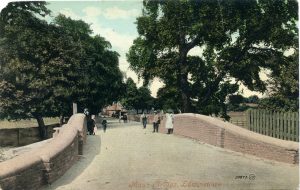
Maun Bridge, Edwinstowe. c.1910
Shirley Moore, Chair, welcomed 38 members and visitors who had braved the elements to attend the meeting and illustrated talk which was presented by members of the Edwinstowe Historical Society. The talk related to the River Maun and followed its journey from source at Kirkby-in-Ashfield continuing north easterly through Mansfield, Edwinstowe, Ollerton, Markham Moor and West Drayton where it loses its identity to the River Idle eventually joining the River Trent at West Stockwith.
Shirley referred to the September 1994 edition of the former community newspaper “The Acorn” that listed 48 groups and organisations in the village at that time, and was proud to acknowledge that the Edwinstowe Historical Society which was inaugurated in the 1960’s, was one of the few remaining groups. The oldest being the Edwinstowe Cricket Club.
Recent updates to the website related to Cockglode House (Rev. William Sterne’s family); Edwinstowe Hall (the Alexander family); and Geoffrey Palmer, author.
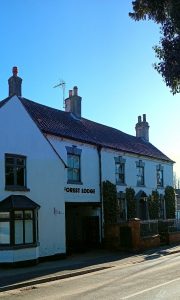 In January members of the Edwinstowe Historical Society met for lunch at the Forest Lodge hotel in Edwinstowe. A former coaching inn thought to have been built in 1774, it has provided accommodation and sustenance for travellers for many years. During that time the proprietors have changed, so too has the name of the establishment, in turn being known in 1885 as Forest House – a boarding house with dining and refreshment rooms; Forest Side Café -providing high class refreshments (1937); Forest House Café (1947); Bullivants restaurant (1993); and subsequently Forest Lodge
In January members of the Edwinstowe Historical Society met for lunch at the Forest Lodge hotel in Edwinstowe. A former coaching inn thought to have been built in 1774, it has provided accommodation and sustenance for travellers for many years. During that time the proprietors have changed, so too has the name of the establishment, in turn being known in 1885 as Forest House – a boarding house with dining and refreshment rooms; Forest Side Café -providing high class refreshments (1937); Forest House Café (1947); Bullivants restaurant (1993); and subsequently Forest Lodge
Just one of the many establishments in the village, which catered for visitors to Sherwood Forest including many well-known 19th century writers, poets and artists who gained inspiration from the surroundings. The opening of the station for passenger service in 1896 brought trippers into the village. For past generations the first choice for refreshment when leaving the station might have been a visit to the Station Tea Rooms, or the splendid Dukeries Hotel, followed by a stroll into the village passing the Black Swan Inn, the Jug and Glass, Birkland House temperance tea rooms, the Royal Oak and the Forest Lodge. Next would be a walk in the forest to see the Major Oak, perhaps stopping to purchase a drink from Granny Bullimore’s stall on Forest Corner, while keeping an eye open for one of the popular cycling clubs.
In January members of the Edwinstowe Historical Society met for lunch at the Forest Lodge hotel in Edwinstowe. A former coaching inn thought to have been built in 1774, it has provided accommodation and sustenance for travellers for many years. During that time the proprietors have changed, so too has the name of the establishment, in turn being known in 1885 as Forest House – a boarding house with dining and refreshment rooms; Forest Side Café -providing high class refreshments (1937); Forest House Café (1947); Bullivants restaurant (1993); and subsequently Forest Lodge.
Just one of the many establishments in the village, which catered for visitors to Sherwood Forest including many well-known 19th century writers, poets and artists who gained inspiration from the surroundings. The opening of the station for passenger service in 1896 brought trippers into the village. For past generations the first choice for refreshment when leaving the station might have been a visit to the Station Tea Rooms, or the splendid Dukeries Hotel, followed by a stroll into the village passing the Black Swan Inn, the Jug and Glass, Birkland House temperance tea rooms, the Royal Oak and the Forest Lodge. Next would be a walk in the forest to see the Major Oak, perhaps stopping to purchase a drink from Granny Bullimore’s stall on Forest Corner, while keeping an eye open for one of the popular cycling clubs.

Forest Lodge
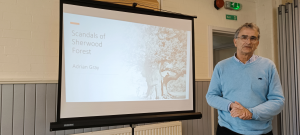 Shirley Moore, Chair for the Edwinstowe Historical Society, welcomed members and visitors to the October meeting and introduced Adrian Gray, with his illustrated talk ‘The Top Ten Scandals from Sherwood Forest’.
Shirley Moore, Chair for the Edwinstowe Historical Society, welcomed members and visitors to the October meeting and introduced Adrian Gray, with his illustrated talk ‘The Top Ten Scandals from Sherwood Forest’.
Adrian left his audience in no doubt that events between the 17th and 19th centuries kept the press and the gossips busy. His talk shed light on the highs and lows of society, with the aristocracy at Bestwood Lodge, Clumber House, Thoresby Hall, Newstead, Welbeck and Rufford Abbeys, all making a contribution.
There was an incestuous relationship, a bigamous marriage, suggestion of a double life, men arrested when dressed in ladies’ clothes, a title bestowed on an illegitimate offspring, and a divorce requiring an Act of Parliament. Plenty of scope here for today’s authors!
The current display in the Sherwood Forest Art and Craft Centre is devoted to sport, and has a selection of photographs of the village cricket and football teams. Cricket has been played in Edwinstowe for more than 200 years and one of the first official football matches took place in 1893.
Shirley reminded members that the Society’s Data Protection Policy, and the Constitution, have now been added to the website. An enthusiastic response was received when members were asked if they were interested in attending a lunch in January. Further details would be circulated in the next few weeks.
Shirley Moore, Chair of the Edwinstowe Historical Society, introduced Ian and Diane Hibbert whose selection of Elizabethan music was a prelude to David Templeman’s talk about “Arbella Stuart – the Queen That Never Was”. David explained that Bess of Hardwick orchestrated a marriage between her daughter, Elizabeth Cavendish, and Charles Stuart son of the Countess of Lenox, in the knowledge that any child of Charles Stuart had a claim to the throne after the death of the childless Elizabeth 1. The marriage was arranged at Rufford Abbey, and their daughter Arbella was born in 1575.
Following the death of her parents, at the age of six Arbella became the ward of her grandmother Bess. She was highly educated and spent time at the court of Queen Elizabeth, but was banished for misbehaviour and became exiled at Hardwick, which she found frustrating. During the reign of her cousin, King James I, she married William Seymour, 2 nd Duke of Somerset, in secret. The King imprisoned William and placed Arbella under house arrest. They managed to keep in touch but their planned dramatic escape to France did not succeed and Arbella was recaptured and imprisoned in the Tower, although William managed to reach safety on the continent. Arbella never saw William again, and she starved herself to death at the age of 39.

At a well-attended meeting in September, Shirley Moore, Chair, welcomed Bob Massey who left no stones unturned when he revealed some of the murders, mysteries and mayhem in the Nottingham area during the past centuries. Sherwood Forest was the home to many outlaws during the 13th and14th centuries, especially the Coterel and de Folville gangs. Surviving court records covering Sherwood Forest indicate that many of the events reported bear resemblance to the tales of Robin Hood. Cannibalism in Nottingham? In the 14 th century the city was subjected to the worst famine in history, with inevitable consequences. Crime and punishment, death and mourning were referred to in detail. From 1558 until 1827 executions took place on Gallows Hill, Mansfield Road, Nottingham on the site of Rock Cemetery entrance, before moving to High Pavement in the city. As a warning to travellers if they broke the law, there was a gibbet at the junction where Mansfield Road (A60) joins the old Rufford Road (A614) at Leapool roundabout.
A recent request has been received from John Hayman, Associate Professor in the Dept. of Clinical Pathology, University of Melbourne, Australia, seeking permission to include in Wikitree the Society’s information relating to his ancestor, Henry Telford Hayman. The Rev. Hayman was a well-respected vicar at St Mary’s Church, Edwinstowe from 1884 until 1907. John also asked to join the Edwinstowe Historical Society as a “colonial member”. Needless to say, there was no hesitation in welcoming him as the first Honorary Colonial Member. Another honorary member is Margaret Woodhead, the sole remaining founder-member of the Edwinstowe Historical Society.
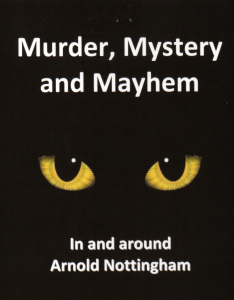

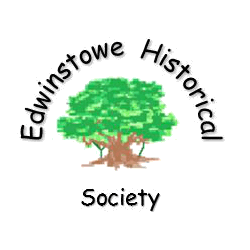 Edwinstowe Historical Society
Edwinstowe Historical Society


 In January members of the Edwinstowe Historical Society met for lunch at the Forest Lodge hotel in Edwinstowe.
In January members of the Edwinstowe Historical Society met for lunch at the Forest Lodge hotel in Edwinstowe.  Shirley Moore, Chair for the Edwinstowe Historical Society, welcomed members and visitors to the October meeting and introduced Adrian Gray, with his illustrated talk ‘The Top Ten Scandals from Sherwood Forest’.
Shirley Moore, Chair for the Edwinstowe Historical Society, welcomed members and visitors to the October meeting and introduced Adrian Gray, with his illustrated talk ‘The Top Ten Scandals from Sherwood Forest’.
